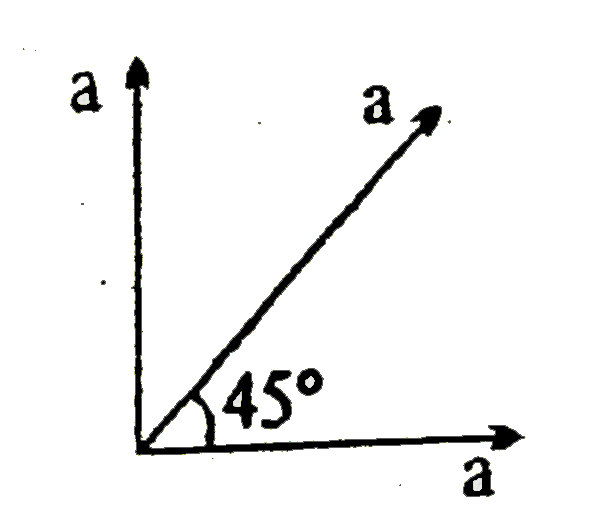Three simple harmonic motions in the same direction having each of amplitude "a" and the same period are superposed. If each differs in phase from the next by π/4 then
Resultant amplitude is (√2+1) a
Phase of resultant motion relative to first is 90∘
The energy associated with the resulting motion is (3+2√2) time the energy associated with any single motion
Maximum speed of resultant SHM will be more than double of the initial SHM's
The correct Answer is:A, C, D
(A)The vector sum of these three is (√2+1) a
(C) Energy associated with each wave =Ka2
Energy with resultant motion =K(√2+1)2a2⇒(3+2√2)
(D) Vmax=Aω
V∈itial=aw
Vrestant–––––max=(√2+1)aω=2.14aω
:.Vrestant–––––72timeV∈itial

Topper's Solved these Questions
- MASTER PRACTICE PROBLEMBOOK - BANSALCHAPTER - MASTER PRACTICE PROBLEMEXERCISE - Subjective
107 Videos
- MASTER PRACTICE PROBLEMBOOK - BANSALCHAPTER - MASTER PRACTICE PROBLEMEXERCISE - Additional topic
70 Videos
- MASTER PRACTICE PROBLEMBOOK - BANSALCHAPTER - MASTER PRACTICE PROBLEMEXERCISE - Reasoning
75 Videos
- FLUID MECHANICSBOOK - BANSALCHAPTER - FLUID MECHANICSEXERCISE - PYQS AIEEE
10 Videos
- SEMICONDUCTORSBOOK - BANSALCHAPTER - SEMICONDUCTORSEXERCISE - CBSE Question
32 Videos
Similar Questions
Three simple harmonic motions in the same direction having same amplitude and the same period are superposed. If each differs in phase from the next by λ/2 then which of the following is wron.
(i) Resultant amplitude is (√2+1) a
(ii) Phase of resultant motion relative to first is 90∘
(iii) The energy associated with the resulting motion is 3 times the energy associated with any single motion
View SolutionA particle is subjected to two simple hasrmonic motions in the same direction having equal amplitudes and equal frequency. If the resultant amplitude is equal to the amplitude of the individual motions, find the phase difference between the individual motions.
View Solution
Knowledge Check
Three simle harmionic motions in the same direction having the same amplitude (a) and same period are superposed. If each differs in phase from the next by 45∘, then.
Athe resultant amplitude is (1+√2aBthe phase of the resultant motion relative to the first is 90∘Cthe energy associated with the resulting motion is (3+2√2) times the energy associated with any single motion.Dthe resulting motion is not simple harmonic.Three simple harmonic motions in the same direction having the same amplitude and same period are superposed. If each differ in phase from the next by 45∘, then
Athe resultant amplitude is (1+√2)aBthe phase of the resultant motion relative to the first is tan−1(12)Cthe energy associated with the resulting motion is (3+2√2) times the energy associated with any single motion.Dthe resulting motion is not simple harmonicThree simple harmonic motions in the same direction each of amplitude a and periodic time T, are superposed. The first and second and the second and third differ in phase from each other by π4, with the first and third not being identical . Then.
Athe resultant motion is not simple harmonicBthe resultant amplitude is (√2+1)aCthe phase difference between the second SHM and the resultant motion is zero.Dthe energy in the resultant motion is three times the energy in each separate SHM.
A particle is subjected to two simple harmonic motions in the same direction having equal amplitude and equal frequency. If the resultant amplitude is equal to the amplitude of individual motions, what is the phase difference between the motions.
View SolutionA particle is subjected to two simple harmonic motion in the same direction having equal amplitudes and equal frequency. If the resultant amplitude is equal to the amplitude of the individual motions. Find the phase difference between the individual motions.
View SolutionA particle is subjected to two simple harmonic motions in the same direction having equal amplitudes and equal frequency. If the resulting amplitude is equal to the amplitude of individual motions, the phase difference between them is
View SolutionWhen two mutually perpendicular simple harmonic motions of same frequency, amplitude and phase are susperimposed
View SolutionThree simple harmonic waves , identical in frequency n and amplitude A moving in the same direction are superimposed in air in such a way , that the first , second and the third wave have the phase angles ϕ,ϕ+(π/2)and(ϕ+π), respectively at a given point P in the superposition
Then as the waves progress , the superposition will result in
View Solution
